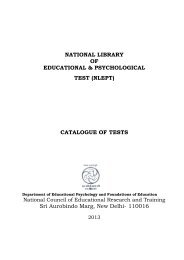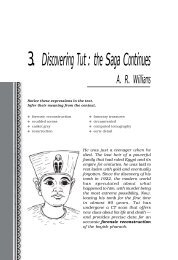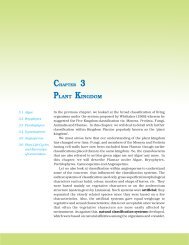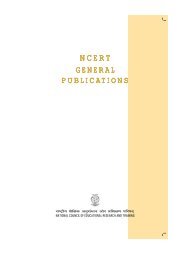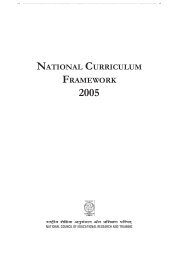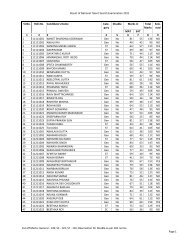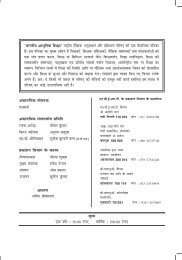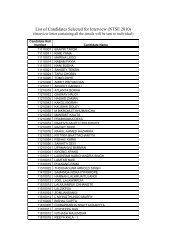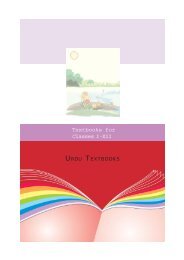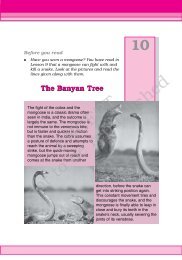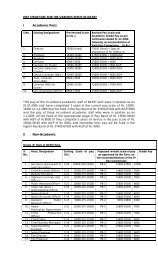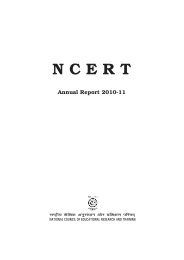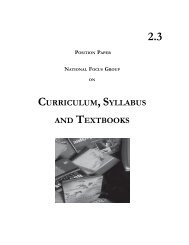indian education - National Council Of Educational Research And ...
indian education - National Council Of Educational Research And ...
indian education - National Council Of Educational Research And ...
You also want an ePaper? Increase the reach of your titles
YUMPU automatically turns print PDFs into web optimized ePapers that Google loves.
Reinventing the Paradigm of Teaching 55<br />
Gardner believed the potential impact of<br />
computer technology would not be felt<br />
until the next century, 2013 to be exact<br />
(Howard Gardner, 1999).<br />
Table 2 and 3 depicts how Internet<br />
could help teacher in preparing lesson<br />
plans with an entirely different<br />
dimension. The promise of marrying<br />
technology with the pedagogy is one that<br />
can be realised today. The Internet based<br />
pedagogy gives a scope to the teacher to<br />
incorporate flexibility to meet individual<br />
needs.<br />
Steps to Incorporate WWW in the<br />
Teaching-learning Process<br />
● Step one would be to collect<br />
multimedia Web sites. Generally<br />
referred as Hot list containing<br />
bookmarked sites that are most<br />
useful, interesting, and/or peculiar<br />
for a given topic and a variety of<br />
learners.<br />
● Second step would be the collection<br />
of online newsletters, desktop slide<br />
presentations, and Hyper Studio<br />
stacks that would focus on<br />
providing links to a variety of<br />
subject-related multimedia<br />
resources. All these can be grouped<br />
together in a Multimedia Scrapbook<br />
which is built around what the<br />
individual learner defines as<br />
meaningful and helpful.<br />
● Third step to target specific-learning<br />
behaviours using online multimedia<br />
resources by posing questions that<br />
motivate students and generates<br />
curiosity for learning. Treasure<br />
Hunt as designed by teacher where<br />
students are given a list of specific<br />
sites that hold information that<br />
appeal to several multiple<br />
intelligences and are essential for<br />
understanding a given topic.<br />
● Fourth step the Subject Samplers<br />
where teacher presents six to eight<br />
captivating Web sites organised<br />
around a main topic. Students<br />
develop a sense of connection with<br />
the topic because they are asked<br />
to respond to Web-based activities<br />
like to explore or compare<br />
interpretations of pictures, data, or<br />
sounds and share (by posting<br />
online) experiences they have had.<br />
● Fifth step Web Quests help students<br />
go beyond learning basic facts. It<br />
requires student to work in groups<br />
with a challenging task, provides<br />
access to an abundance of online<br />
resources and scaffolds.<br />
Networked technologies add new<br />
dimensions in organising learning<br />
experiences:<br />
● Revealing the quality resources.<br />
● Preparing students for the work<br />
environments of the future.<br />
● Networking at various levels like<br />
among students, among faculty,<br />
and among students, faculty, and<br />
professionals beyond the University.<br />
Thus, web-based teaching-learning<br />
practice generally called as Webagogy is<br />
the art, craft, and science of using<br />
networked technologies. As it is rightly<br />
pointed out by Boettcher (1997) “Now<br />
that the Worldwide Web is providing a<br />
whole new context for teaching and<br />
learning, we have the need to return to<br />
the core principles of teaching and<br />
learning, and create a new model of<br />
teaching and learning. Technology,<br />
applied in conjunction with pedagogical<br />
concepts can create an effective student-



